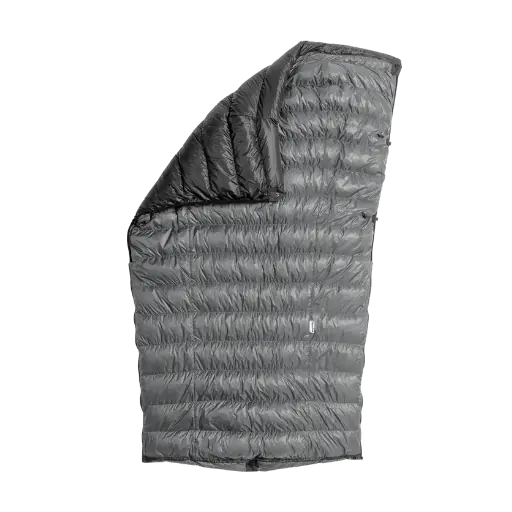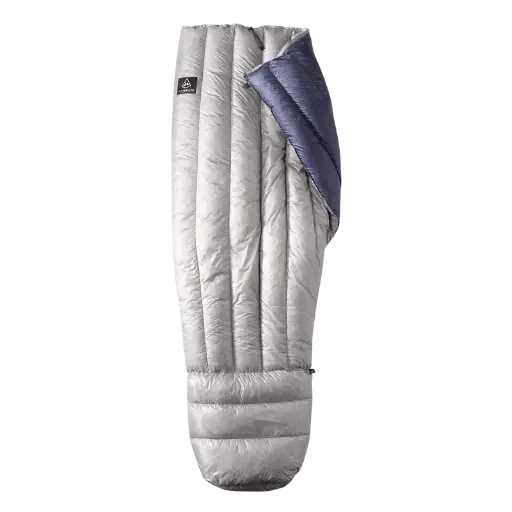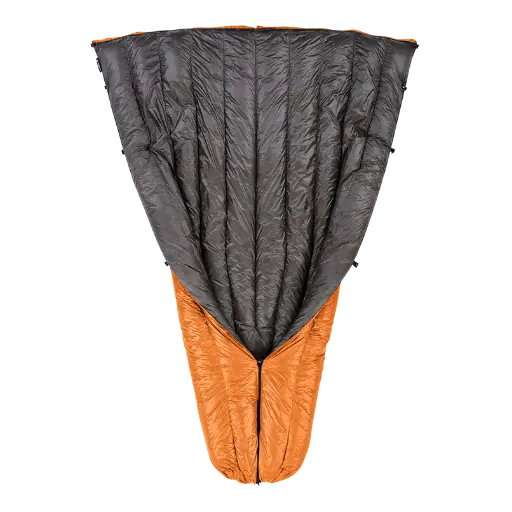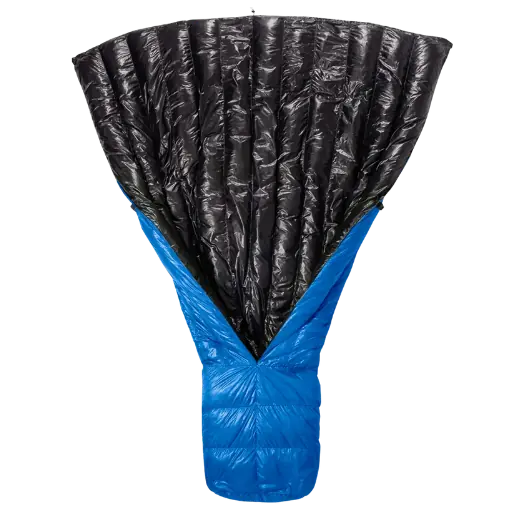When you are looking to gear up properly for a long-distance thru-hike, you want to maximize performance to the weight of the gear to provide the maximum benefits, so what is a backpacking quilt?
A backpacking quilt is similar to a sleeping bag, but instead of having a hood and long zipper to close up, a quilt removes the down and fabric that provides little benefit under you while sleeping and adds more, in many cases, to the top side to insulate you against the cold air.
Let's dig in a little more and cover why choosing a quilt over a sleeping bag has been more and more popular in the outdoors and then the benefits they give someone willing to make the change to their gear.
After this, we will talk about the current favorite quilts, from a hiker trash favorite to the budget and honorable mentions that can get the job done for you if you decide to convert over.
The Key Differences Between Bags and Quilts
You would think when you look at the two next to each other that there are very few core differences between the sleeping bag and the sleeping quilts.
There are two big differences between a backpacking quilt and a sleeping bag which come down to the removal of the zipper and hood, the removal of the bottom fabric, and related fill. These two things help to lower the weight for the same providing warmth dramatically.
The big reason for a quilt to be able to drop weight versus a similar sleeping bag is in the removal of the unnecessary fabric and down. Many people don't know that down is worthless when compressed so anything under you in a sleeping bag provides you NO protection.
Quilts vs Bags: Which is Better for Thru-Hiking?
So when you want to start reading and deciding on your gear, you may wonder more about whether a backpacking quilt is better than a sleeping bag for the average thru-hiker.
Some who side sleep or people who shift a lot in their sleep tend to prefer a quilt, they are just about equal to each other in the 3-season use. Many will argue a sleeping bag is better to use in 4 seasons, of extremely cold weather, as the hood and wrapping help keep all the vital heat inside.
So, as you read they aren't better but in the game of thru-hiking where you run on a limited timeframe with only the goods on your back, those few pounds they can help you drop can mean a large difference over 6 months.
Let's look at how the quilt works and why it is a good match for the other things you will already be carrying with you on a long-distance trail.
How Quilts Trap Heat and Keep You Warm
At the core, a down quilt for backpacking works by keeping the heat in from the air, not allowing it to escape when properly set up. This ability to add the "lost" insulation to the top instead of being under your body helps to generate more heat and keep more in.
The quilt, though will depend on your choice of the sleeping pad as the heat lost to the ground is not managed by the quilt, and this is the number one reason why people say their quilt (and sleeping bag) don't work to recommended temperatures.
You must build an excellent overall sleep system for a quilt to perform to the best values. The colder it gets adding a sleeping liner, and much higher the R-Value needs to be on a sleeping pad if going into 20 degrees you NEED to have at least a 4 R-Value. If not, you will lose heat to the ground, and it will be miserable.
Attaching Your Quilt to Your Sleeping Pad
Since a sleeping bag encloses me and protects me from the ground and drafts on a sleeping pad, we have straps or cords that can anchor the quilt onto your sleeping pad to help keep you on the pad.
Most quilts will come with attachment straps or similar cords that run from one side around the back of the sleeping pad to help keep you contained and connected. For some quilts, this will be an add-on, though so be certain if you want them to check with the quilt maker details.
Now that you know how to keep your quilt connected to your sleeping pad we can look into the additional benefits that a backpacking quilt can give you on your trip to make it more comfortable and warm.
9 Reasons to Ditch Your Mummy Bag for a Quilt
I have assembled an extensive and helpful list of the reasons why I made the change along with maybe why you would consider the change to a backpacking quilt vs sleeping bag for your next long hike.
Less Pack Weight
A key feature and benefit of a backpacking quilt versus a sleeping bag is the drop in overall weight for the same warmth. Since the sleeping pad removes the zipper, fabric, and insulation from the bottom your overall pack weight drops.
Many people worry about their heads being cold without a mummy-style hood area, for those who experience cold heads you could look at something like the EE Torrid Hood, or wear a beanie that you probably already carry.
Less Space and Volume in Your Backpack
An additional win is that without a zipper and the additional fabric the quilt takes up much less volume within your backpack, this allows you to get into smaller backpacks and move into lighter carries.
Equal Warmth
While a sleeping bag is arguably warmer, newer quilts and manufacturing have made these much better in helping retain heat. Adding methods to keep the quilt from allowing drafts helps to contain the warmth just like a sleeping bag nowadays.
Less Restrictive to Movement
This point is what sold me on a backpacking quilt after using a sleeping bag my entire life, I move a lot, shifting shoulder to shoulder. In a sleeping bag, this is restrictive and isn't easy to adjust without waking up more, now I sleep awesome!
Less Cost
On average versus a similar sleeping bag, a quilt will typically be less expensive due to fewer materials and less labor to create the backpacking quilt versus the same sleeping bag.
Less Moisture Buildup
Since your head is exposed you aren't breathing moisture into your backpacking quilt, this happens a lot with people who toss and turn when in a sleeping bag.
Built to be Paired with a Sleeping Pad
Where a sleeping bag has deflated down or synthetic insulation under you a backpacking quilt was built specifically to take advantage of the value a sleeping pad provides as it keeps in heat from the ground.
Fewer Malfunctions
By removing the zipper you remove some of the issues that can come with having the additional mechanical movement. This means nothing to snag over or break while sliding so you won't have a bad night.
Breathability
After you start to relax you may become overly sweaty depending on the effort and the speed of slowdown prior to making camp, the ability to breathe and let your body relax and decompress from the day is VITAL to long-term success.
Should you get sweaty breathability is the ability of the material to ensure you aren't still damp as when it gets cold the worst thing is damp and cold together as that can be very dangerous!
Customization Options
For most quilt manufacturers you will have a large assortment of options in colors, fabrics, fill, foot box, and much more.
This can allow you to customize and build yourself the best quilt for your needs and not stick with just what is available.
The Takeaway: Why Quilts Are Ideal for Thru-Hikers
While I prefer a quilt and am pretty sure that I will never use a sleeping bag again but they are something that requires adjustment to how you sleep.
If you are a heavy winter hiker and camper, you may need to evaluate if a sleeping quilt will be perfect for your needs but if you are a three-season hiker a quilt is perfect for any time!
There is no argument in top quilt vs sleeping bag that a backpacking quilt is lighter, compresses better, and in many cases costs much less than the exact same option as a sleeping bag.
Highly Beloved Backpacking Quilts
The below are a perfect match for anyone looking to take on a thru-hike on any long-distance trail, and they can all ensure your safety and warmth as long as you take care of your gear.

Katabatic Flex 22
This Katabatic has become my goto quilt for when I hit colder weather, rated to 22 degrees at comfort it can take you down colder depending on if you sleep cold.

HMG 20-Degree Quilt
Built for form and purpose using 1000-fill power down and 7d micro ripstop nylon exterior shell, the 20-Degree Quilt is warm, comfortable, incredibly light, and exceedingly packable.

EE Revelation 20
One of the most beloved cottage backpacking quilt manufacturers used in thru-hikes around the world. The Revelation is able to be fully opened into a blanket to allow use in all weather.

Zpacks Solo Quilt
Zpacks has long been a favorite of thru-hikers as they use quality materials and have shown the test of time to last the entirety of one or more hikes.






